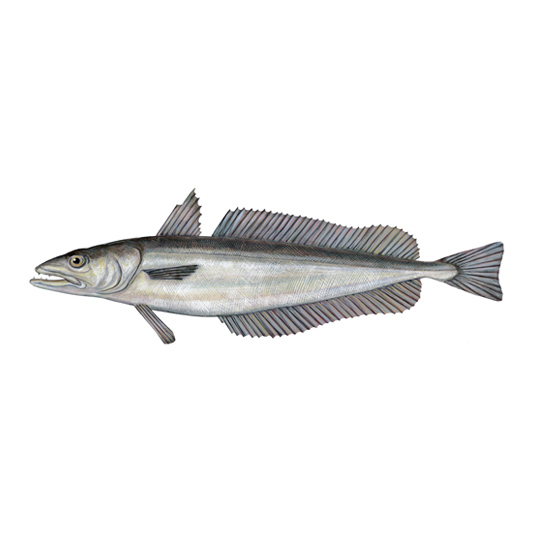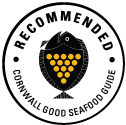

A predatory fish with white tasty flesh that is prized by the Spanish. Hake makes a great alternative to cod, is great battered and in Spain is traditionally cut into steaks and baked.

Cornish Waters
MSC certified fishery. Gill nets are lightweight nets made of nylon (monofilament) fishing line that are anchored to the seabed and are used to catch fish by entangling the gills.
Learn more
Cornish vessels landing to Cornish ports
Demersal trawls are large nets that are pulled through the water with the bottom edge of the net touching the seabed. At each edge the net is pulled open by metal ‘trawl doors’. Sometimes referred to as Otter trawling.
Learn moreCornwall Good Seafood Guide rates fish on sustainability using a scale of 1 to 5.
1, 2 and 3 are recommended, Fish to avoid are rated 5.
We use the system devised by the Marine Conservation Society (MCS) so our scores are comparable with the scores produced by MCS for the UK and fisheries from all around the world. For more information on scoring click here.
There was a pronounced stock decline in the 1980's, with spawning stock biomass (SSB) hitting a historical low in 2000. Following the introduction of a recovery management plan in 2004, the spawning stock biomass rapidly increased until 2017 and is now stable. Fishing mortality decreased sharply between 2004 and 2102 and since then has been stable at the Maximum sustainable yeild target. Quotas for hake have risen as a result of the health of this stock. This is a well managed stock.
Hake fisheries are managed by the European Common Fisheries Policy quota system. Additionally a hake recovery plan implemented in 2004 has resulted in increased hake stocks. Cornish vessels operating outside the 12 mile limit all now are required by law to use accoustic pingers on their nets which deter dolphins and porpoises from coming near the nets. The Cornish Gill net hake fishery was certified as sustainable by the Marine Stewardship Council in 2015.
Hake are caught by demersal trawls and beam trawls but the majority of landings are by targetted gill netting fisheries. Hake net fisheries are mainly carried out in deep water outside the 6 mile limit and all netters fishing from boats over 10 meters now have to use pingers on their nets to reduce risk of cetacean by catch. The nets used have a mesh size of 4" 7/8 (124mm) and are set on the seabed. A typical hake net is 125 yards long and 32 nets are joined together to make a tier of nets. A large, offshore, modern hake netter can fish up to 6 tiers of net at a time - an astounding 21 kilometers of net. There are issues with by-catch of non target species such as sharks, rays and seals in this fishery and more research is needed to establish the level of by catch.
For a detailed description of the Cornish Hake net fishery visit Ajax hakes website here






Cornwall Good Seafood Guide is underpinned by the Marine Conservation Society (MCS) Good Fish Guide. The first UK consumer guide to sustainable seafood. For more information visit www.fishonline.org
Cornwall Good Seafood Guide is here to help us all make sustainable seafood choices. Choices that will help us keep the oceans healthy and Cornish fishers' futures safe. This website is funded by Cornwall Wildlife Trust. If you would like to make a meaningful difference to the health of our oceans, please consider making a donation to the Cornwall Wildlife Trust Ocean Emergency fund. Your donation will help safeguard these remarkable environments, ensuring that they continue to thrive for generations to come. Together, we can be stewards of the seas and champions for a healthier, more sustainable future.